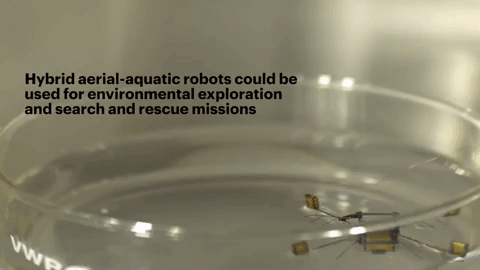Another day, another bioinspired drone. But this microrobot, powered through a wire tether, can launch itself through the air and into water — then blast itself back into the air.
Harvard researchers have been working on bee-like robots for years, and a new study published Wednesday in Science Robotics shows more advancement. Scientists showed the little bot could successfully hover in the air, transition from air to water, swim, takeoff from the water and land on the water, according to the paper.
“This is the first microrobot capable of repeatedly moving in and through complex environments,” said Yufeng Chen, first author of the paper and former graduate student in the Microrobotics Lab at SEAS when the research was conducted, in a news release. “We designed new mechanisms that allow the vehicle to directly transition from water to air, something that is beyond what nature can achieve in the insect world.”
The robot weighs just 175 milligrams. Its small size and the density difference between water and air—water is 1,000 times denser than air—meant researchers had to get creative to make it traverse both fluids. Ultimately, they found flapping wings can propel the bot in both environments.
But how the heck does it get out of the water? Once the bioinspired bot’s done swimming, it flaps its wings to get back to the surface. A set of buoys trap surrounding water into a chamber with an electrolytic plate. The plate then converts water into oxy-hydrogen (a combustible gas that used to be widely used) which ignites a sparker, shooting the robot into the air. Science is so awesome.
The researchers say this hybrid microrobot could be used for search-and-rescue, environmental exploration and monitoring, and biological studies.
Love when drones and nature intersect? Learn how drones are helping save fawns from terrible fates.
